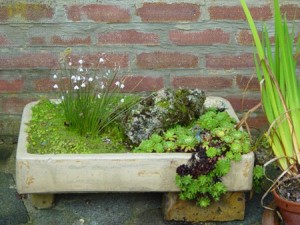





 Apart from the conventional tub or half-barrel, other small contained water features can be created, often from unconventional vessels. One of the most interesting and potentially attractive is the old kitchen sink, which can be transformed from a utilitarian object into a miniature waterscape.
Apart from the conventional tub or half-barrel, other small contained water features can be created, often from unconventional vessels. One of the most interesting and potentially attractive is the old kitchen sink, which can be transformed from a utilitarian object into a miniature waterscape.
This type of scaled-down water feature will need regular care if it is to maintain its character. The reason for this is that although the plants used should be of dwarf stature and modest growth, they will quickly overwhelm the waterscape if not rigorously controlled.
A sink is not normally the most attractive of objects, unless you are fortunate enough to find an old stone type. A glazed sink will need rendering if it is to be acceptable visually. This is not difficult provided that you use the correct mixture to produce a hypertufa finish, which will mellow naturally.
To produce hypertufa, mix two parts by volume of moss peat, one part of sand and one part of cement in their dry state. When thoroughly combined, add water until the mixture is stiff and capable of being applied to the sink like plaster. To ensure that it adheres well, spread a liberal amount of PVA adhesive over the exterior of the sink to act as a bonding agent. After approximately 15 minutes, the adhesive will become tacky, at which point the hypertufa mixture can be applied with a small pointing trowel. Coat the outside of the sink with about 1.25cm (1/2in) of hypertufa mixture, taking it down inside approximately 7.5cm (3in) so that when water is added, the level will be above the rendered finish.
The surface is best left slightly rough and uneven for a natural look, but if you want to produce a replica of a stone sink, very careful smoothing will be required if the result is not to look contrived. Once dry, the hypertufa will produce a tough and weather-resistant coating. Its appearance can be ‘aged’ artificially by painting the surface with a mixture of milk and cow dung, then standing the sink under cover until it has dried. This unsavoury concoction is a traditional and very effective method of encouraging development of moss and algal growth, which also mellows the colour of the coating. Live yoghurt or a manure solution could also be used.
The waterscape within the sink should be simple if it is to be effective. One or two pieces of rock, positioned strategically so that they just appear above water, will be ideal. The gaps between the edge of the sink and the rocks should be filled with aquatic planting compost to allow a degree of planting. When choosing rocks for a miniature waterscape, avoid sandstone and limestone, for they often crumble when kept immersed in water.
Copyright © www.100flowers.win Botanic Garden All Rights Reserved